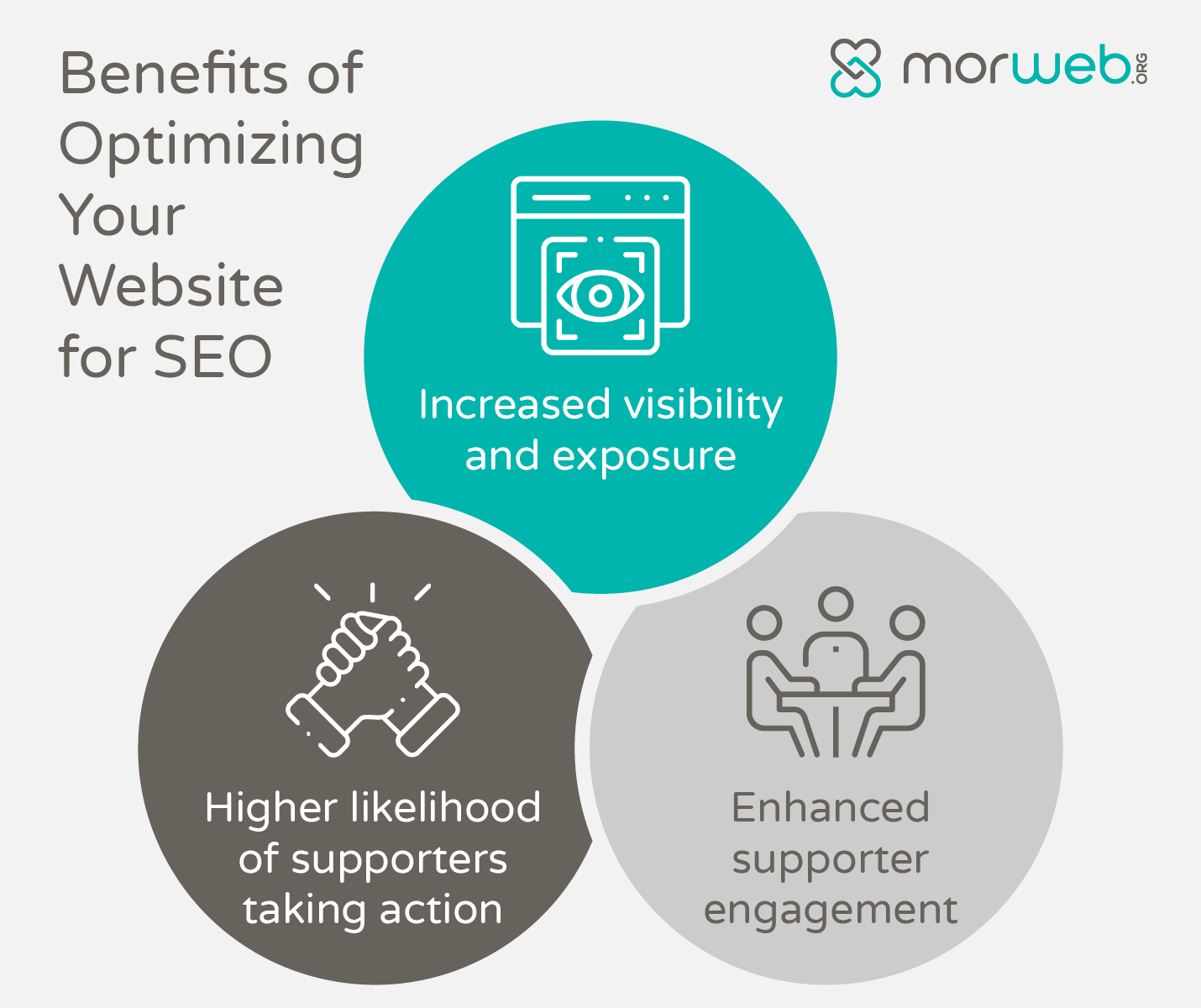Chances are, your nonprofit uses its website as a central information hub. Here, people can learn more about the history of your organization, your mission, and how you serve the community. They may even use your website to donate, sign up to volunteer, or register for an event.
However, none of this is possible if prospective supporters can’t find your website in the first place. With so many charitable organizations competing for attention on the web, how can you make your website stand out and boost traffic?
Search engine optimization (SEO) is crucial for nonprofits to increase their online visibility, attract more supporters, and raise awareness about their cause. We’ll cover these SEO best practices specifically tailored to nonprofit organizations:
- Create a keyword strategy.
- Develop quality content.
- Make your website mobile-friendly.
Before we dive into how you can optimize your nonprofit website for SEO, let’s make sure you have the basics covered.
What is search engine optimization (SEO)?
SEO refers to the practice of optimizing your nonprofit’s website to improve your visibility on search engine results pages (SERPs). The primary goal of SEO is to increase organic traffic to your website by ranking higher for search engines like Google when users search for relevant keywords and phrases.
There are several benefits of optimizing your website for SEO, including:
Alt Text: Benefits of optimizing your website for SEO, as discussed in the text below.
- Increased visibility and exposure. Adding SEO to your digital marketing strategy allows you to expand your reach and garner more support for your cause.
- Enhanced supporter engagement. When you provide users with relevant content that matches the intent of their online searches, they’ll be more likely to interact with your organization’s website and other digital channels.
- Higher likelihood of supporters taking action. Whether they’re donating, signing up to volunteer, or registering for an event, supporters can more easily find your website and take their desired action, helping you push your mission forward and meet your fundraising goals.
Rather than manually optimizing your website for SEO, which can take up way too much of your organization’s time and quickly feel overwhelming, Morweb recommends working with a nonprofit website builder that has built-in SEO tools so you can start ranking faster—no coding necessary.
Create a keyword strategy.
Keywords refer to the words or phrases that supporters type into search engines like Google. By targeting certain keywords that your audience is likely to search for, you increase the chances that your nonprofit’s website will appear at the top of the SERP when supporters type in their search query.
Use these tips to create your keyword strategy:
- Make your keywords relevant to your target audience. Put yourself in the minds of prospective supporters and beneficiaries to determine which keywords they might be searching for. If you’re stuck, try sending a survey to your current supporter base to get an idea of which topics relevant to your cause most interest them.
- Avoid generic keywords. Be specific with your keywords so you land on terms that actually meet supporters’ search intent. For example, as opposed to targeting overly generic terms like “cats” and “dogs,” an animal shelter should select keywords like “volunteering with cats in South Florida” or “adopting a dog in the Bay Area” that better reflect their services.
- Find the sweet spot between high volume and low competition. When developing your keyword strategy, you want to choose words or phrases that many people are searching for but not too many other organizations are targeting. Use a tool like Moz or SEMRush to find keywords that strike a balance between high volume and low competition.
Once you’ve determined which keywords you’d like to target, make sure to naturally weave these phrases or words into relevant pages on your website. For instance, a healthcare association may create a page that targets the keyword “healthcare professional networking” and covers opportunities for industry professionals to connect.
Develop quality content.
The website content you create should be informative, credible, and visually appealing so you can meet user intent, provide value to your audience, and build relationships with supporters.
To strengthen your content quality, keep these best practices in mind:
- Focus on your mission, clearly communicating what you stand for and how you’re making a difference.
- Use authoritative sources and statistics to build trust and credibility.
- Develop a variety of content, including a well-designed homepage, landing pages, and blog posts.
- Prioritize seamless navigation by using a navigation bar and website builder with ready-to-go website templates that are already optimized for accessibility and user experience.
To create consistency across your digital marketing channels, all website content should also follow your brand guidelines. For instance, you may decide upon specific fonts, colors, logos, and visual styles that you’d like all content to include so you can build brand recognition online.
Make your website mobile-friendly.
According to 360MatchPro, mobile users made up 33% of online donation transactions last year. This means that supporters are more frequently using their phones to engage with nonprofits online, and by optimizing your website for mobile, you can bring in more donations.
Use these tips to make your website mobile-friendly:
- Make sure all buttons and prompts are clickable. Double-check that users can click on all buttons on your site and that they lead to the correct links.
- Avoid using pop-ups. Pop-ups can distract users from important content on the page. On mobile devices, they may also visually block content and be difficult for users to close if the pop-up isn’t designed for smaller screens.
- Prioritize having a fast loading speed. The faster your site loads on mobile devices, the more likely users will stay and become avid supporters, donors, volunteers, or advocates.
- Ensure text and images automatically resize to different-sized devices. While you can use tools like Lighthouse to audit your mobile performance, the right content management system (CMS) will automatically optimize your website for mobile to save your team time and offer an enhanced user experience.
When you make your website mobile-friendly, you not only provide a better user experience but also improve your SEO standing. Google prioritizes featuring pages that are mobile-friendly, allowing you to reach a wider audience.
Wrapping Up
With a comprehensive SEO strategy, you ensure your website reaches potential supporters and beneficiaries. As a result, you’ll maximize donations, recruit more volunteers, and connect people in need with your services.
To easily optimize your website for SEO, work with a comprehensive website builder. That way, you can focus on creating your keyword strategy and web content while automating more technical aspects of SEO like mobile-friendliness.
About the Author
Murad Bushnaq is the Founder and CEO of Morweb. Since its inception in 2014, Murad has acted as Creative Director and Chief Technologist to help nonprofits spread their vision online through engaging design, intuitive software and strategic communication.

